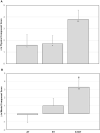Aerobic, Resistance, and Combination Training on Health-Related Quality of Life: The STRRIDE-AT/RT Randomized Trial
- PMID: 33644749
- PMCID: PMC7905223
- DOI: 10.3389/fspor.2020.620300
Aerobic, Resistance, and Combination Training on Health-Related Quality of Life: The STRRIDE-AT/RT Randomized Trial
Abstract
Purpose: The main purpose of this study was to determine the differential effects of aerobic training (AT), resistance training (RT), and a combination of aerobic and resistance training (AT/RT) on changes in self-rated HrQoL measures, including the Short-Form 36 (SF-36) survey and Satisfaction with Physical Function and Appearance survey. We also sought to determine if combination training (AT/RT) has a more or less additive effect compared to AT or RT alone on self-rated HrQoL measures. Materials and Methods: Participants (n = 137) completed one of three 8-month exercise interventions: (1) AT: 14 kcal exercise expenditure per kg of body weight per week (KKW; equivalent to roughly 12 miles/week) at 65-80% of peak oxygen consumption; (2) RT: 3 days per week, 8 exercises, 3 sets per exercise, 8-12 repetitions per set; (3) AT/RT: full combination of the AT and RT interventions. The SF-36 survey, Satisfaction with Physical Function and Appearance survey, physical fitness, and anthropometrics were assessed at baseline and post-intervention. Paired t-tests determined significant pre- vs. post-intervention scores within groups (p < 0.05). Analyses of covariance determined differences in change scores among groups (p < 0.05). Results: On average, participants were 49.0 ± 10.6 years old, obese (BMI: 30.6 ± 3.2 kg/m2), female (57.7%), and Caucasian (84.7%). Following the 8-month intervention, exercise groups improved peak VO2 (all groups), strength (RT and AT/RT), and anthropometric measures (AT and AT/RT). For the SF-36, RT (p = 0.03) and AT/RT (p < 0.001) significantly improved their physical component score; only AT/RT (p < 0.001) significantly improved their mental component score. Notably, all groups significantly improved both their satisfaction with physical function and appearance scores (All Groups: p < 0.001 for both outcomes). Conclusions: We found that aerobic, resistance, or combination exercise training improves several components of self-rated HrQoL, including physical function, appearance, and mental well-being. Clinical Trial Registration: No. NCT00275145.
Keywords: behavior change; exercise training; obese; overweight; physical activity; quality of life; self-perception.
Copyright © 2021 Collins, Fos, Ross, Slentz, Davis, Willis, Piner, Bateman, Houmard and Kraus.
Conflict of interest statement
The authors declare that the research was conducted in the absence of any commercial or financial relationships that could be construed as a potential conflict of interest.
Figures



 AT/RT pre-intervention score.
AT/RT pre-intervention score.  AT/RT post-intervention score.
AT/RT post-intervention score.  RT pre-intervention score.
RT pre-intervention score.  RT post-intervention score.
RT post-intervention score.  AT pre-intervention score.
AT pre-intervention score.  AT post-intervention score. Panel A: Satisfaction with physical function pre/post scores by intervention group. Panel B: Satisfaction with physical appearance pre/post scores by intervention group. Error bars indicate SE. Significant within group change: **p-value < 0.001. δp-value < 0.01 Tukey's Post-Hoc Test compared with aerobic + resistance training.
AT post-intervention score. Panel A: Satisfaction with physical function pre/post scores by intervention group. Panel B: Satisfaction with physical appearance pre/post scores by intervention group. Error bars indicate SE. Significant within group change: **p-value < 0.001. δp-value < 0.01 Tukey's Post-Hoc Test compared with aerobic + resistance training.References
-
- Awick E. A., Wójcicki T. R., Olson E. A., Fanning J., Chung H. D., Zuniga K., et al. (2015). Differential exercise effects on quality of life and health-related quality of life in older adults: a randomized controlled trial. Qual. Life Res. 24, 455–462. 10.1007/s11136-014-0762-0 - DOI - PMC - PubMed
-
- Bateman L. A., Slentz C. A., Willis L. H., Shields A. T., Piner L. W., Bales C. W., et al. (2011). Comparison of aerobic versus resistance exercise training effects on metabolic syndrome (from the Studies of a Targeted Risk Reduction Intervention Through Defined Exercise-STRRIDE-AT/RT). Am. J. Cardiol. 108, 838–844. 10.1016/j.amjcard.2011.04.037 - DOI - PMC - PubMed
-
- Choi B. C. K., Pak A. W. P. (2005). A catalog of biases in questionnaires. Prev. Chronic Dis. 2:A13. Available online at: http://www.cdc.gov/pcd/issues/2005/jan/04_0050.htm - PMC - PubMed
Associated data
LinkOut - more resources
Full Text Sources
Other Literature Sources
Medical

